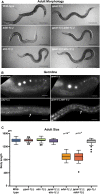Purine Homeostasis Is Necessary for Developmental Timing, Germline Maintenance and Muscle Integrity in Caenorhabditis elegans
- PMID: 30700528
- PMCID: PMC6456310
- DOI: 10.1534/genetics.118.301062
Purine Homeostasis Is Necessary for Developmental Timing, Germline Maintenance and Muscle Integrity in Caenorhabditis elegans
Abstract
Purine homeostasis is ensured through a metabolic network widely conserved from prokaryotes to humans. Purines can either be synthesized de novo, reused, or produced by interconversion of extant metabolites using the so-called recycling pathway. Although thoroughly characterized in microorganisms, such as yeast or bacteria, little is known about regulation of the purine biosynthesis network in metazoans. In humans, several diseases are linked to purine metabolism through as yet poorly understood etiologies. Particularly, the deficiency in adenylosuccinate lyase (ADSL)-an enzyme involved both in the purine de novo and recycling pathways-causes severe muscular and neuronal symptoms. In order to address the mechanisms underlying this deficiency, we established Caenorhabditis elegans as a metazoan model organism to study purine metabolism, while focusing on ADSL. We show that the purine biosynthesis network is functionally conserved in C. elegans Moreover, adsl-1 (the gene encoding ADSL in C. elegans) is required for developmental timing, germline stem cell maintenance and muscle integrity. Importantly, these traits are not affected when solely the de novo pathway is abolished, and we present evidence that germline maintenance is linked specifically to ADSL activity in the recycling pathway. Hence, our results allow developmental and tissue specific phenotypes to be ascribed to separable steps of the purine metabolic network in an animal model.
Keywords: ADSL deficiency; AICAR; SAICAR; SZMP; ZMP; metabolism; purine salvage pathway.
Copyright © 2019 by the Genetics Society of America.
Figures






Similar articles
-
A Caenorhabditis elegans model of adenylosuccinate lyase deficiency reveals neuromuscular and reproductive phenotypes of distinct etiology.Mol Genet Metab. 2023 Nov;140(3):107686. doi: 10.1016/j.ymgme.2023.107686. Epub 2023 Aug 15. Mol Genet Metab. 2023. PMID: 37607437 Free PMC article.
-
Adenylosuccinate lyase deficiency affects neurobehavior via perturbations to tyramine signaling in Caenorhabditis elegans.PLoS Genet. 2023 Sep 29;19(9):e1010974. doi: 10.1371/journal.pgen.1010974. eCollection 2023 Sep. PLoS Genet. 2023. PMID: 37773959 Free PMC article.
-
MicroRNA-21 guide and passenger strand regulation of adenylosuccinate lyase-mediated purine metabolism promotes transition to an EGFR-TKI-tolerant persister state.Cancer Gene Ther. 2022 Dec;29(12):1878-1894. doi: 10.1038/s41417-022-00504-y. Epub 2022 Jul 15. Cancer Gene Ther. 2022. PMID: 35840668 Free PMC article.
-
Adenylosuccinate lyase deficiency.J Inherit Metab Dis. 2015 Mar;38(2):231-42. doi: 10.1007/s10545-014-9755-y. Epub 2014 Aug 12. J Inherit Metab Dis. 2015. PMID: 25112391 Free PMC article. Review.
-
Disorders of purine biosynthesis metabolism.Mol Genet Metab. 2022 Jul;136(3):190-198. doi: 10.1016/j.ymgme.2021.12.016. Epub 2021 Dec 30. Mol Genet Metab. 2022. PMID: 34998670 Review.
Cited by
-
The purine nucleoside phosphorylase pnp-1 regulates epithelial cell resistance to infection in C. elegans.PLoS Pathog. 2021 Apr 20;17(4):e1009350. doi: 10.1371/journal.ppat.1009350. eCollection 2021 Apr. PLoS Pathog. 2021. PMID: 33878133 Free PMC article.
-
Circadian ontogenetic metabolomics atlas: an interactive resource with insights from rat plasma, tissues, and feces.Cell Mol Life Sci. 2025 Jun 28;82(1):264. doi: 10.1007/s00018-025-05783-w. Cell Mol Life Sci. 2025. PMID: 40580317 Free PMC article.
-
Pathway-specific effects of ADSL deficiency on neurodevelopment.Elife. 2022 Feb 8;11:e70518. doi: 10.7554/eLife.70518. Elife. 2022. PMID: 35133277 Free PMC article.
-
Purine Biosynthesis Pathways Are Required for Myogenesis in Xenopus laevis.Cells. 2023 Sep 28;12(19):2379. doi: 10.3390/cells12192379. Cells. 2023. PMID: 37830593 Free PMC article.
-
Yeast to Study Human Purine Metabolism Diseases.Cells. 2019 Jan 17;8(1):67. doi: 10.3390/cells8010067. Cells. 2019. PMID: 30658520 Free PMC article. Review.
References
Publication types
MeSH terms
Substances
Associated data
Grants and funding
LinkOut - more resources
Full Text Sources
Research Materials

